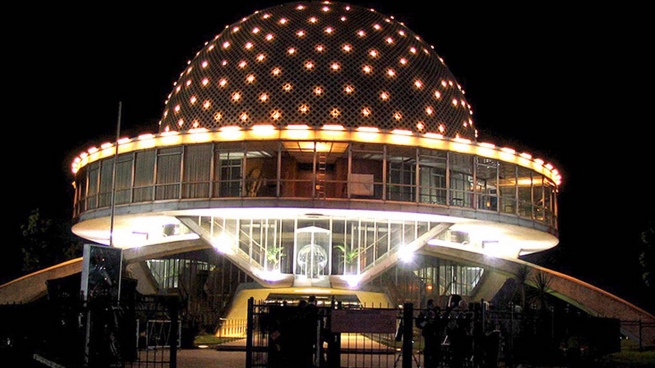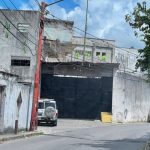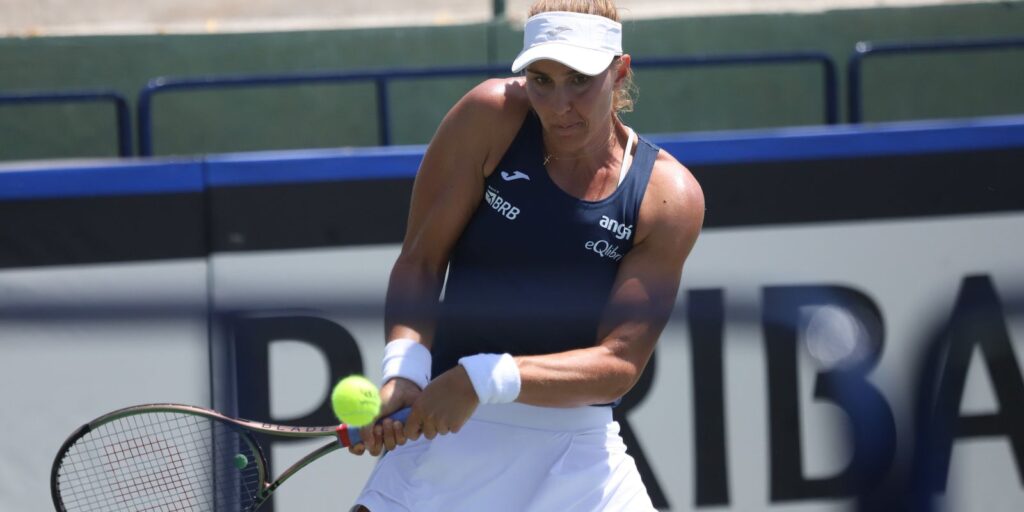On Monday they celebrate 55 years of the first function of Galileo Galilei Planetarium of Buenos Airesa period in which this “astronomy theatre” changed the mechanical projectors and glass lamps for a digital system, but always linked to the public -it is visited by 400,000 people a year- and holding the flag of popular science Two people who worked there throughout its history told Télam.
For more than half a century, the Planetarium has had the power to turn day into night: the public enters a room that suddenly darkens and more than 4,000 stars appear above their heads in a hemispherical dome 20 meters in diameter.

“These stars are not invented, but are copied in position, color and brightness of the real sky”explained in dialogue with Télam Mariano Ribas, coordinator of the Scientific Dissemination area of the Buenos Aires Planetarium.
The planetarium is a device that is in the center of the room and projects points of light that are replicas of all the stars.
The planetarium is a device that is in the center of the room and projects points of light that are replicas of all the stars, said the journalist and disseminator specialized in Astronomy.

“If you turn it on now, you can see tonight’s sky or recreate the sky of the year 500 or 7,000. Today we can move time forward or backward at will,” Ribas said.
Today the planetarium has the ability to electronically reproduce the night of any time and place in the worldand it takes no more than five minutes to prepare the astronomical parameters on the computer.

But this was not always so. The first function of the Planetarium was on June 13, 1967 for students of the Commercial School No. 1 of Banfield and the College of the Holy Union of the Sacred Hearts, of what was then called the Federal Capital.
At that time, the heart of the building was a mechanically operated German Zeiss planetarium that was 5 meters high and weighed 2.5 tons.
There were no seats in the room and the students stood up and saw what the sky would be like over Buenos Aires, Antarctica and the South Pole that night, guided by the director of the Planetarium, Professor Antonio Cornejo.
“I couldn’t believe that what I was seeing wasn’t the real sky. I kept thinking about how difficult it would be to build such a device full of little holes,” Elena Schvartz told Télam, who, in 1967, at 14 years old, was one of the Banfield students who participated in the first experimental performances.

Nevertheless, the official inauguration for the public would arrive the following year, on April 5, 1968, date in which three performances were presented and the line reached from the door of the Planetarium to the corner, in the Parque Tres de Febrero in Palermo.
“There was a great expectation to know what the reaction of the people was going to be and it was an ovation,” Juan Carlos Forte recalled in dialogue with Télam, who is a doctor in Astronomy and a member of the National Academy of Sciences, but who at that time He began his career as part of the technical team of the Buenos Aires astronomical center.
“The first function had ended and people did not leave the room. They came to ask,” said Forte, who was dean of the Faculty of Astronomical and Geophysical Sciences of the National University of La Plata (UNLP) and university professor for 40 years.
The memory of the first visitors
The first experimental performances of the Galileo Galilei Planetarium were marked by fascination and amazement, recalled a group of graduates from the Commercial School No. joy that he felt when seeing above his head an immensity of stars and planets that until that day they had only seen in books.
“We couldn’t believe we saw all the stars and everything they showed us”told Télam Graciela Esponda, who was 16 years old when she visited the Planetarium for the first time with her classmates from Banfield’s Commercial School No. 1, which at that time was called Abraham Lincoln Middle School No. 1.
“Everything was a great impact, from arriving and seeing tremendous construction, to the shows inside and discovering the world of planets, stars and galaxies that until that day we had only seen in theory with books at school,” he added. Grace.
The first experimental function was held on June 13, 1967 and until the official opening for the general public on April 5, 1968, only students were worked on.
Banfield students were invited to these practical functions by Professor Antonio Cornejo, who had been the director of the school until he was appointed head of the Planetarium, an institution that he would direct for more than 33 years.
“Professor Cornejo had lecture hours in Geography and was a warm, kind and respectful person. When he left his position as director, his absence was greatly felt,” said Elena Schvartz, another graduate of the Abraham Lincoln School.
When she was 14 years old, Elena visited the Planetarium and remembers it like this: “I was forever fascinated and I went back several times. I couldn’t believe that what I saw wasn’t the real sky.”
Luis, a third-year classmate from the same division, told Télam that he still has recorded from the show the moment when the sunset was projected and all the stars and planets appeared.
“We went with Cornejo and I found the program fascinating,” he said and assured that since then he has developed a passion for contemplating the sky.
“I have a window in my room that looks to the East and if I wake up at 4 it is a spectacle to see the alignment of Jupiter, Saturn, Mars and Venus before dawn. It’s like my own Planetarium!”, he concluded.

At the age of 17, Forte was already an electromechanical technician and was in charge of adjusting the planetarium: “Periodically we had to align the lamps, the position of the planets and keep the gears properly lubricated.”
To program the instrument, sky maps and astronomical ephemerides were used to adjust the position of each planet to the appropriate date, which lasted only a couple of months and then had to “go back with a screw and a clamp and touch the suitable gears”, specified the researcher. And he added that since it was such an artisanal system, he came to “know the sky by heart.”
Although for that time it was an advanced device, it was exposed to risks that could suspend the function, such as one of the main lamps, which were made of glass and had a diameter of about 30 centimeters, burning out.
“You had to handle them with gloves, very carefully because they broke and also cost a fortune. I had to make that change and I still remember it because it was like walking a tightrope, an entire operation with instructions that came from the factory manual,” Forte pointed out and noted that the working conditions “were harsh because the construction was not completely finished and some glass was missing, so it was seriously cold.”

From his days at the institution, he still retains a anecdote especially: “Once there was a visit from the wives of ambassadors in Argentina and we knew there was going to be some question about the Southern Cross, but when the function began it was not there, the lamps had burned out.”
“So, Professor Cornejo moved the planetarium to project the sky of the North Pole, where the Southern Cross cannot be seen, and with a colleague we went in the dark with flashlights and screwdrivers to change the lamp before the device moved. back,” he continued.

In 55 years of history, various technology upgrades such as the incorporation of 22 special effects projectors in 1981, the replacement of the original planetarium by a Megastar II A model Planetarium, which shows stars of up to 11th magnitude, and the complete technological renovation of the room in 2011 allowed to maintain the quality in the projections and guarantee the immersive experience.
“The Planetarium is an astronomy theater and an education and outreach center based on democratizing access to scientific knowledge”Mariano Ribas, coordinator of the Scientific Dissemination area of the Buenos Aires Planetarium
“The Planetarium is an astronomy theater and an education and outreach center based on democratizing access to scientific knowledge,” said Ribas, specifying that of the nearly 400,000 people it receives each year, half are students.
Although the Planetarium has changed a lot since its inception, at a cosmic level its 55 years are “less than the blink of an eye”, Ribas indicated and explained that “the sky that one sees now is essentially the same at the same time, place and date as our great-great-grandparents saw and what our great-grandchildren are going to see; it is an imperceptible change for the human eye”.

What has changed is how we see the sky from below. “In 1967, four times more stars were seen in Buenos Aires than today because there was less light pollution,” Forte added, mentioning that when astronomy fans created the Planetarium project, they already foresaw that “the sky was going to be progressively erased.”
55 years after the first performance, recreating the ideal sky and maintaining the amenity of the content without losing scientific rigor continue to be the challenges faced by the Planetarium every time the lights go out and the stars come out.

The festivities: a week of performances and free guided tours
The Galileo Galilei Planetarium in Buenos Aires will hold next week free features with cinematic-quality animations and visualizations to celebrate its 55th anniversary, while it will also be possible to take guided tours of the building and participate in online classes.
The show titled “The Birth of the Earth: Origin and evolution of our planet” It is an immersive proposal for the general public with animations and visualizations of great cinematographic quality, based on data of high scientific rigor.
The functions that propose knowing the history and evolution of our planet, and what possibilities exist to find other worlds similar to ours, will be held on June 14, 15 and 16 at 5:00 p.m.
Tickets will be free and to reserve places you must access the planetarium sitewhere tickets will be available from Monday, June 13 at 12.
There will also be free guided tours of the building, the Astronomical Plaza and the Museum on June 17, 18 and 19 at 10:30 and 11:30.
Other activities will be the launch of the new edition of the popular science magazine Si Muove and the dictation of various master classes that can be followed live through the YouTube channel Y Facebook Planetarium BA.


















